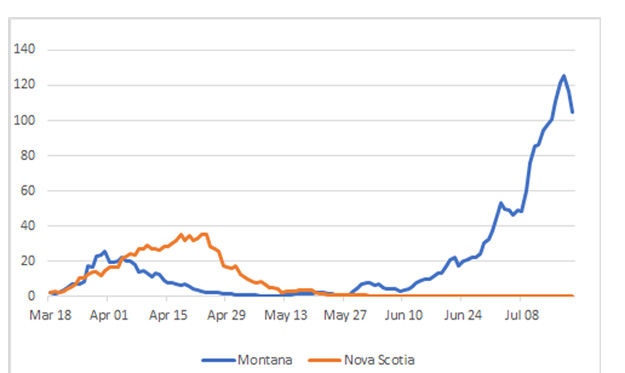Posted July 23, 2020
I started looking at Montana a few weeks ago when it had the lowest number of cases per capita in the continental US. It is interesting to compare it to Nova Scotia because the two areas have roughly the same population (approximately 1 million) and had their first cases at roughly the same time (in the second week of March).
Figure 1 below compares the experience in the two areas.
Figure 1. Cases per day (5 day rolling average) in Montana and Nova Scotia
From the figure, we can make three major observations concerning the 5 day average number of cases per day:
- The number of cases peaked earlier in Montana and at a lower level (roughly 25 per day in Montana versus 35 in Nova Scotia.)
- By late May, things were largely under control in both areas (roughly 1 case per day in Nova Scotia and less than 1 in Montana).
- From the last few days of May until today, the situation in the two areas started to differ radically. In Nova Scotia the decline in case numbers continued to decrease to almost 0 new cases per day – a total of only 7 for the last 30 days. In Montana, cases numbers started to increase dramatically with the 5 daily average increasing to almost 5 times that reached in the first peak in late March and a total of 1881 cases in the last 30 days.
In summary, two months ago (May 22) Montana was doing much than Nova Scotia – a total of 479 cases versus 1048 in Nova Scotia. Today, the situation has completely reversed – a total of 2813 total cases in Montana versus 1067 in Nova Scotia.
What happened?
In the following I will look at government actions and other differences between the two jurisdictions which explain the discrepancies outlined above.
Initial Surge and Government lockdown Actions
In mid March, both jurisdictions took similar steps including:
- Closure of schools
- No gatherings
- Closure of non essential services including bars and sit-down restaurant service
- Requirement for incoming travelers to self-isolate for 14 days
- No personal contact except with immediate family remembers living in the same residence
As mentioned above, this was successful in both jurisdictions but with Nova Scotia taking longer to reach a peak and with more than twice as many total cases. The reasons for this higher rate in Nova Scotia are likely a combination of:
- Higher population density (roughly 7 times more people per sq. km. in Nova Scotia). Furthermore, Montana has no large metropolitan area (Halifax has roughly 4 times the population of Montana’s largest city, Billings)
- A large number of international arrivals at Halifax Airport
- A significant outbreak in a large senior citizen’s home in Halifax – 32% of all cases in the province and 85% of the deaths.
Reopenings and Impact
Key Dates
The following summarizes the Montana phased reopenings:
Phase 1: April 27• Churches open with physical distancing• Gatherings of up to 10 permitted• Non essential businesses alowed to open• School boards have the option of opening schools• (May 4) Bars and eat in restaurants allowed to open
Phase 2: June • Gatherings of up to 50 permitted• Gyms, indoor group fitness classes, pool, and hot tubs allowed to operate at 75% capacity• Concert halls, bowling alleys, and other places of assembly allowed to operate with reduced capacity• Bars, restaurants, etc. allowed to operate at 75% capacity
In contrast, reopening in Nova Scotia was much more cautious. The following summarizes a few highlights:
- By mid May: Many outdoor activities (golf, camping, etc.) were permitted and two household family bubbles authorized.
- May 29: Gatherings of up to 10 people permitted – 15 for wedding or funeral if held outside
- June 5: Bars, restaurants, hair salons, gyms, etc. allowed to open at 50% capacity
- June 18: gatherings up 50 people permitted with social distancing – relaxed to 250 for events run by “recognized organization” on July 3
- July 3: Travel to and from 3 neighbouring (largely COVID free) provinces permitted without self isolation requirement.
From the above, one can see that in Nova Scotia where the reopening lagged that in Montana by more than a month and gathering size, restaurant and bar capacity are still more limited than they have been for almost two months in Montana
The Outcome
The slower, more cautious reopening in Nova Scotia has obviously paid off asthe disease has almost disappeared in the province – just 7 cases in the last 30 days and only 1 active case remaining.
Looking at Figure 1, we can see that, in Montana:
- The first uptick in case numbers occurred in roughly 3 weeks after the reopening of bars and restaurants
- The truly significant rise started around June 12 (10 days after the Phase 2 reopening and growth accelerated from there (exponential growth with the number of cases more than doubling in the last 2 weeks).

Pingback: Montana versus Nova Scotia COVID Update – Doug and Marilyn Pincock